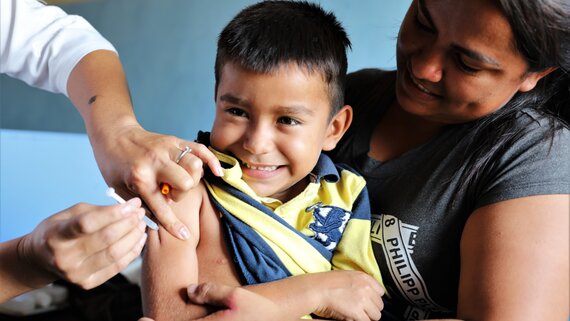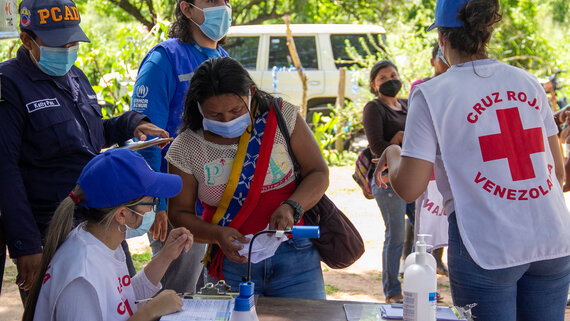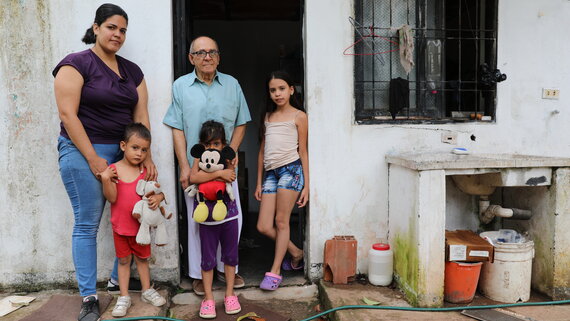Analysis of the context, crisis and needs
Prolonged and significant economic contraction, chronic inflation with episodes of hyperinflation, political polarization and localized violence remain key drivers of humanitarian needs in Venezuela. In 2021, a modest recovery in oil production and a series of liberalizing economic measures have slightly improved economic performance and helped curb inflation. The GDP contraction in 2021 is estimated at 4 per cent, up from -30 per cent in 2020, with the economy expected to grow in 2022. However, the continued economic contraction and the impact of broad sectoral sanctions continue to impact the provision of essential services such as health care, water and sanitation, education and domestic gas, fuel and electricity supply. The deterioration of public service delivery has negatively impacted the lives and livelihoods of vulnerable families. Protection-related services to address violence, abuse, neglect and exploitation, including mental health and gender-based violence (GBV) have also been affected.
COVID-19 has also aggravated the humanitarian situation, with quarantine measures leading to reduced economic activities, including formal employment opportunities, impacting production and trade and increasing domestic violence. People’s incomes, savings and purchasing power have been affected. While food and non-food items are available, vulnerable families face difficulties accessing these due to decreased purchasing power. The informal dollarization of the economy has also led to increased prices, and while there have been regular adjustments to the minimum wage, accompanied by social cash transfers, these are not sufficient for vulnerable families to cover their basic needs, especially for those without access to foreign currency.

San Joaquin de Navay, Venezuela
A mother holds her smiling son while he receives a measles vaccination at a health clinic in southern Venezuela. She said: "I brought my son for immunization because I don’t want him to fall sick. I know that immunization will strengthen his immune system, which will help him fight other diseases."
OCHA/Gema CortésFood security and nutrition remain a key concern, since the rate of undernourishment has increased from 2.5 per cent in 2010-2012 to 27.4 per cent in 2018-2020.
During 2021, the COVID-19 pandemic heavily strained the health-care system. As of 15 November 2021, 419,745 cases had been confirmed and 5,026 people had died. New variants of the virus have generated new waves of the pandemic. In October, the country reported the highest weekly increase in new cases since the pandemic began, putting pressure on ICU capacity. Limited early access to vaccines constrained the country's initial response. However, as of 12 November, the vaccination rate has increased, with 32.3 per cent of the population fully vaccinated. Key challenges in the COVID-19 response include limitations in regular access to energy, safe water and safe waste-disposal services in health facilities, limited diagnostic capacity and personal protective equipment, and the departure of qualified health personnel.
The focus on COVID-19 curtailed the provision of other essential health services, particularly in the case of chronic diseases and access to sexual and reproductive health, and the implementation of the regular vaccination programme, impacting recent gains in the control of vectorborne diseases.

Machiques, Venezuela
In May 2021, dozens of families of the Yukpa ethnic group living in the Apon Basin had to leave their homes due to flooding. By November 2021, UNHCR had delivered more than 800 kits of NFIs to cover basic needs in coordination with the Red Cross, Civil Protection and OCHA.
OCHA/Wildi RiveroThe pandemic also affected people’s well-being, with an increase in mental health and psychosocial support consultations for children, adolescents and caregivers. School closures to mitigate the spread of COVID-19 affected 6.8 million students in the country. Estimates indicate that at least 20 per cent of students had difficulty completing the school year through remote modalities, with children in remote areas, with disabilities and from indigenous communities being the most affected. The return to in-person classes started on 25 October 2021. Ensuring safe conditions in educational facilities and supporting teachers, and vulnerable children and adolescents are critical elements for attendance and retention in the school system.
Mixed migration flows continue, including people intending to leave, returnees and/or people engaged in cross-border pendular movements. The closure of the borders with neighbouring countries throughout most of 2021 forced people to use irregular routes and crossings, which increases protection risks, including human trafficking and gender-based violence.
In 2021, the rainy season affected thousands of people due to overflowing rivers, landslides and floods in several areas of the country, including Apure, Bolivar, Cojedes, Merida, Yaracuy and Zulia states among others.

Cardenas, Venezuela
A vulnerable family in front of their house in Cardenas, where living conditions are precarious. While the economic contraction has affected people’s capacity to access food, COVID-19 has turned thousands of lives upside down. The pandemic has hampered the capacity of this mother of three to put food on the table, every morning she worries about how to feed her family.
OCHA/Gema CortésProjected situation in 2022 and beyond
Humanitarian needs are likely to continue due to the prolonged economic and sociopolitical situation and the impact of COVID-19. Critical issues include the delivery of basic services, food insecurity and malnutrition, human mobility and protection needs.
The country’s GDP is expected to grow 1 per cent in 2022 after eight consecutive years of contraction, which could help stabilize the humanitarian situation in 2022. However, sustainable improvements in the economy will depend on lasting progress in the political dialogue and the evolution of international sanctions. Factors such as the extent of economic reform measures, inflation trends, fuel and electricity supply and the ability to rekindle oil production are key for sustained economic changes.
Response priorities in 2022-2023
In 2022, the humanitarian community in Venezuela will focus on:
- Providing life-saving assistance with critical health, including sexual and reproductive health, nutrition, food security, protection and WASH interventions.
- Improving living standards by strengthening livelihoods, maintaining safe and effective access to essential goods and services, and ensuring safe and dignified shelters for people on the move.
- Prevention, mitigation and protection, including those related to GBV and violence, abuse, exploitation and neglect of children and adolescents. Differentiated needs by age, gender and diversity will be considered.
The Humanitarian Response Plan (HRP) will be multi-annual (2022-23), with the aim of promoting better coordination between humanitarian and development interventions, including an increased focus on the delivery of basic services and institutional capacity-building in essential service areas, including protection services.
Venezuela HRP
Strengthening humanitarian access, especially for NGO partners, will continue to be a priority. The main humanitarian challenges include attempts to politicize humanitarian aid, administrative and bureaucratic impediments, fuel shortages, the temporary suspension of cash-based interventions, the lack of access to official data on needs and the slow implementation of the resolution enabling international NGOs to register in the country.
Humanitarian funding also remains a challenge to scaling up the humanitarian response. The HRP funding gap is currently 63 per cent, with total funding against HRP requirements $260 million, and an additional $119 million going to other humanitarian partners (as of 26 November). The establishment of the Venezuela Humanitarian Fund in 2020 mobilized $14 million and facilitated funding opportunities for local partners.
Further reading
Source: OCHA
Source: Humanitarian Insight
Source: Financial Tracking Service
References
- The number of People in Need is an estimate from 2019. An updated analysis is ongoing to reflect the most recent humanitarian situation; total population figures are from ECLAC's Statistical Yearbook
- Economic Commission for Latin America and the Caribbean (ECLAC), Economic Survey of Latin America and the Caribbean 2020: Labour dynamics and employment policies for sustainable and inclusive recovery beyond the COVID-19 crisis, p. 101.
- FAO, State of Food Security and Nutrition in the World (SOFI) Report 2021. The Government does not agree with these findings.
- ECLAC-PAHO, COVID-19 Report: The prolongation of the health crisis and its impact on health, the economy and social development, October 2021.
- ECLAC-PAHO, COVID-19 Report: The prolongation of the health crisis and its impact on health, the economy and social development, October 2021.
- PAHO, COVID-19 Vaccination in the Americas, as of 29 October 2021.
- UNESCO, Global monitoring of school closures caused by COVID-19.
- ECLAC, Economic Survey of Latin America and the Caribbean, 2021 (LC/PUB.2021/10-P/Rev.1), Santiago, 2021, p. 103.
- The 2022 figures are estimates and will be updated pending the launch of the HRP 2022-2023



